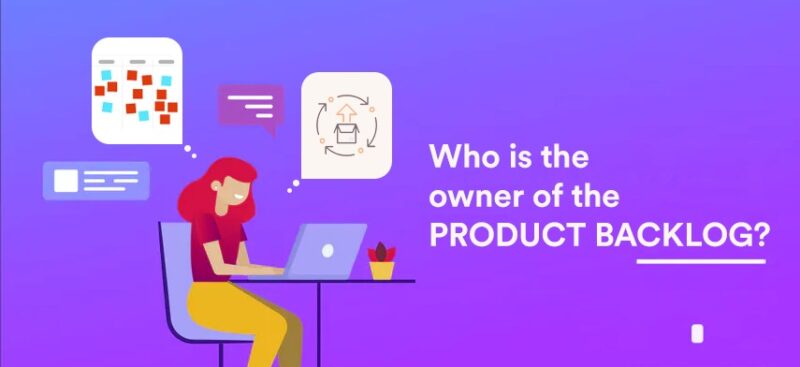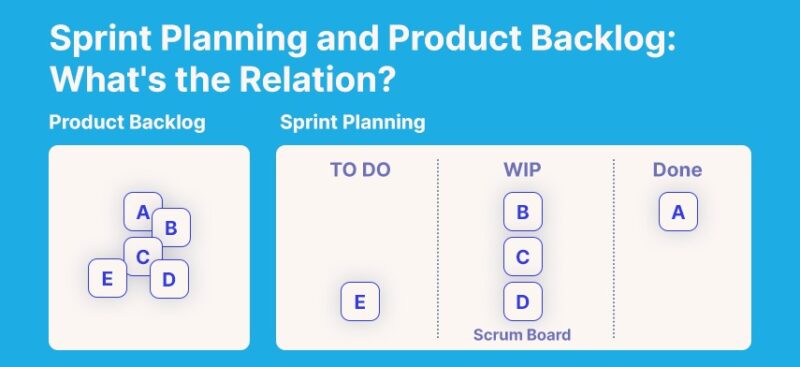
- Agilemania
- Dec 13th 2020
Do you know that every day only 20% of people feel that their work is under control? What’s more shocking is that an average worker spends around 51% of every workday on low-value work. That means most people at work waste their time on work that adds no value to the organization or even the customers' lives. The reason? They don’t know how to prioritize their work effectively. This is where using a product backlog can help you.
In an agile environment, scrum teams use a product backlog to prioritize their work and deliver value to the customer quickly. Think of it as a shopping list for your house. Just as you might have a list of shopping items to buy in order to run your house smoothly, a scrum team has a product backlog of items to make their overall work smooth and productive. In this post, we’ve dived deeper into the ifs and buts of a product backlog so that your organization can run smoothly. So, without further ado, let’s start reading.
What is a Product Backlog?
A product backlog in scrum is a prioritized list of items (often referred to as “user stories”) that represent work that needs to be done in order to deliver a product or service. These items can include new features, bug fixes, and technical tasks. The product backlog is owned by the Product Owner and is used to prioritize and manage the work that the development team will take on during the next sprint.If you want to make any changes to your product, as a product owner only, you will be responsible for its availability, content, priority, and ordering of the product backlog. The product backlog serves as a single source of requirements for the development team, and it never completes. You have to update and refine the product backlog list constantly as the project progresses. This will help the team recognize what your product needs to be perfect, useful, and worth the competition.
In the product backlog, the most important or high-priority works are shown at the top of the backlog. So that the important work always gets tackled first, and the team can work towards delivering value to the customer. As the development team executes the product roadmap’s bigger picture, the product backlog should communicate what comes next on the team’s to-do list. And if you want to make your product backlog perfect, then first, you have to make it DEEP. DEEP is the acronym for Detailed, Estimated, Emergent, and Prioritized.
What Does a Product Backlog Include?
It is a tricky question because what belongs in a product backlog varies from team to team. However, In general, a product backlog includes some typical items like bug fixes, user stories, and other tasks like:- New features
- Enhancement to existing functionalities
- Technical debt
- Infrastructure update
Who is the owner of the product backlog?
The product owner is the only owner of the product backlog. But, the whole cross-functional team together works on the backlog. When it comes to maintaining and organizing the product backlog, the product owner holds complete accountability. While ordering the backlog, the product owner may get influenced by customer priority, difficulty in relative implementation, the urgency of receiving feedback, etc. An efficient product owner will look for feedback from the development team, customers, and designers to optimize product delivery. Here's a heads-up. You can allow other cross-functional team members to contribute items to the product backlog.
What are the Characteristics of Product Backlog
- On a single product backlog, multiple teams can work together.
- Every product should have one product backlog. A product backlog can have a set of large to very large features.
- You can rank the features based on technical and business value, strategic fitness, or risk management.
- Top-ranked items are divided into smaller user stories during the release planning.
What are the Benefits of Using a Product Backlog
The product backlog is a way to put all the product planning and to brainstorm into action. While innovating a product, you'll come across multiple pieces of feedback from your customers or stakeholders. They will share different ideas to improve your products. But you can’t use all the ideas because some of them may not be valuable. So, having a product backlog is essential as it will help you differentiate between a good idea and ideas that would only waste your time.Here are some other benefits of using a product backlog:
- A product backlog is prepared to plan the product roadmap
- The product backlog helps to give estimates for each feature
- You can change the product backlog as the priorities change
- With the product backlog, you can think long-term about the product
- It helps you to re-rank the product features according to values
- Product backlog allows your team to decide what to prioritize and rank the item accordingly
5 Easy Steps to Create a Product Backlog
1. Add Ideas
Your stakeholders or customers will approach you with their different ideas for product development.
2. Clarify the Idea
After getting the ideas about an addition or fix from stakeholders, ensure that you have clarity about the reason behind the fix or addition. Also, get a clear idea about the specification of the item. And, overall, how it contributes to the product.
3. Prioritize Items
The product backlog should be defined clearly with top-priority items. High-priority items are refined and add more significant value to the product. The low-priority items should be at the bottom as they add no or less value. When the items progress to the top priority list, they can add to the next sprint cycle. Pro tip: You can color code the blocks to recognize whether an item is refined properly. When an item is prepared for sprint planning, you can color it green. Also, identify the low-priority items with red and mid-priority items with another color.
4. Update the Backlog
You have to update the product backlog constantly. You will have loads of ideas in your backlog for improving your product. But most of the ideas will require refinement to make their way to development. So, refine, prioritize, and always keep the product updated.
5. Backlog Refinement Sessions
An effective product owner continuously refines the product backlog to make it more reliable. These backlog refinement sessions are also renowned as backlog grooming sessions. The primary objective of these refinement sessions is to prepare the stories to discuss in the sprint planning. In refinement sessions, it is sometimes necessary to break user stories into smaller ones. The backlog refinement or grooming process happens regularly, and it includes:- Analysis and design discussion
- Splitting/ Decomposition of big stories/Epics/Features
- Removing irrelevant stories
- Creation of new stories following the newly discovered requirements.
- Adding new features/epics, then setting estimates for features/epics.
- Correction of estimate following the newly discovered need.
Product Backlog Examples
A product backlog may change based on different projects and organizations. But to give you an idea, here we’ll share an example of a product backlog for a website development team:Product Backlog of a Website Development Team:
Epic: As a website developer, I want to improve an E-commerce website.
User Story 1: As a customer, I want to be able to track my order and find my order history easily.
User Story 2: As a customer, I want to easily find and purchase products from the website.
Features the product backlog should include from stories 1 & 2:
- Add advanced search and filtering options
- Add product reviews to allow customers to purchase based on ratings and reviews
- Add wish lists to help customers wishlist products they'd buy
- Integrate a secure and easy payment gateway
- Make the website mobile responsive for easy mobile access
Product Backlog of a Marketing Team:
Epic: Improve brand awareness and engagement
User Story 1: As a social media manager, I want to increase our social media engagement by 20% in the next quarter, so that we can reach a wide audience.
User Story 2: As a content marketer, I want to create a series of blog posts that educate our audience on the benefits of our service/product so that they are more likely to purchase.
Features the product backlog should include from user stories 1 & 2:
Implement a referral program
- Create a loyalty program
- Develop an influencer marketing strategy
- Write engaging blog posts
- Integrate CRM and marketing automation tools
Sprint Planning and Product Backlog: What's the Relation?
- Backlog grooming or refinement is not part of the scrum events. It is referred to as a GASP (Generally Accepted Scrum Practice), which means it is common practice on various scrums, but it's not a needed task for the scrum team. On the other hand, sprint planning is part of the scrum events.
- Sprint planning works on the tasks a scrum team decides to do during the upcoming sprint. In contrast, backlog refinement tends to enhance the understanding of product backlog's work items.
- Backlog refinement focuses on a long time horizon, and sprint planning is all about a short time horizon.
Product Backlog vs. Sprint Backlog: What’s the Difference?
In Scrum, Product Backlog and Sprint Backlog are both part of the Scrum Artifacts. They aren’t enemies; they are friends! You can’t create a sprint backlog without the presence of a product backlog. Both are needed to show the items required to develop a product or complete a task that meets the “Done” condition in sprint planning. So, what are the differences between product backlog and sprint backlog? Well, the product backlog is a prioritized list of all the items or tasks that need to be completed to deliver a product or service.It is the only source of requirements for the development team for the work progress. An entire scrum team can work together to create the product backlog. But only the product owner is responsible for building, managing, and defining the backlog. On the other hand, the sprint backlog is the subset of the product backlog that contains the tasks or items the development team has agreed to complete during the next sprint.
Also, the sprint backlog helps to estimate the effort needed to complete each task. During a sprint planning meeting, the team first reviews the product backlog and selects tasks that they’ll work on in the next sprint. And these tasks are then moved to the sprint backlog and become the focus of the team’s work for the next sprint. You can create a sprint backlog on a task board so that the entire scrum team can visualize which task they should work on.
Final Thoughts
A product backlog is undoubtedly one of the most crucial tools for any organization working in an agile team. It helps your team to refine, organize, and define work that needs to be done to add value to your product. So, if you’re not using a product backlog yet, it’s time to start. By building a product backlog, you can easily streamline your work and align your team with one business goal. And if you don’t know where to start your product backlog creation journey, enroll in our expert coaching classes today.











